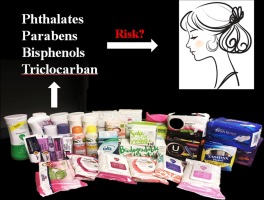当前位置:
X-MOL 学术
›
Environ. Int.
›
论文详情
Our official English website, www.x-mol.net, welcomes your
feedback! (Note: you will need to create a separate account there.)
Phthalates, bisphenols, parabens, and triclocarban in feminine hygiene products from the United States and their implications for human exposure.
Environment International ( IF 10.3 ) Pub Date : 2020-01-13 , DOI: 10.1016/j.envint.2020.105465 Chong-Jing Gao 1 , Kurunthachalam Kannan 2
Environment International ( IF 10.3 ) Pub Date : 2020-01-13 , DOI: 10.1016/j.envint.2020.105465 Chong-Jing Gao 1 , Kurunthachalam Kannan 2
Affiliation

|
Feminine hygiene products, a category of daily necessities, can be a source of exposure to plasticizers and antimicrobial agents in women. Nevertheless, studies on the occurrence of chemicals in feminine hygiene products have received little attention. In this study, 24 endocrine-disrupting chemicals (EDCs), comprising nine phthalates, six parabens, eight bisphenols, and triclocarban (TCC) were measured in seven categories of feminine hygiene products (i.e., pads, panty liners, tampons, wipes, bactericidal creams and solutions, and deodorant sprays and powders; N = 77) collected in the Albany area of New York State in the United States. Dimethyl phthalate (DMP), diethyl phthalate (DEP), dibutyl phthalate (DBP), di-iso-butyl phthalate (DIBP), di(2-ethylhexyl) phthalate (DEHP), methyl paraben (MeP), and ethyl paraben (EtP) were found in all pad, panty liner, and tampon samples. Panty liners contained the highest concentrations of DMP (median: 249 ng/g), DEP (386 ng/g), DBP (393 ng/g), and DIBP (299 ng/g) and tampons contained the highest concentrations of DEHP (267 ng/g). MeP, EtP, and propyl paraben (PrP) were the major parabens found in feminine hygiene products. Bactericidal creams and solutions contained median concentrations of MeP, EtP and PrP at 2840, 734, and 278 ng/g, respectively. The estimated exposure doses of phthalates, parabens, and bisphenols through the dermal absorption pathway from the use of pads, panty liners, and tampons were significant. In comparison with the exposure doses reported previously from other sources and pathways, the significance of feminine hygiene products as sources of EDC exposure was delineated. The dermal absorption doses from the use of feminine hygiene products, under different exposure scenarios, were 0.19-27.9% and 0.01-6.2% of the total exposure doses of phthalates and bisphenols, respectively. This is the first study to report the occurrence of phthalates, parabens, bisphenols, and TCC in feminine hygiene products from the United States.
中文翻译:

美国女性卫生产品中的邻苯二甲酸盐,双酚,对羟基苯甲酸酯和三氯卡班及其对人体暴露的影响。
女性卫生用品是日常必需品,可能是妇女接触增塑剂和抗菌剂的来源。然而,关于女性卫生产品中化学物质的存在的研究很少受到关注。在这项研究中,对七种女性卫生产品(即垫,内裤衬里,卫生棉条,湿巾,杀菌剂)中的24种破坏内分泌的化学物质(EDC)进行了测量,其中包括9种邻苯二甲酸盐,6种对羟基苯甲酸酯,8种双酚和三氯卡班(TCC)。乳霜和溶液,以及除臭喷雾剂和粉末; N = 77)收集在美国纽约州的奥尔巴尼地区。邻苯二甲酸二甲酯(DMP),邻苯二甲酸二乙酯(DEP),邻苯二甲酸二丁酯(DBP),邻苯二甲酸二异丁酯(DIBP),邻苯二甲酸二(2-乙基己基)酯(DEHP),对羟基苯甲酸甲酯(MeP)和对羟基苯甲酸乙酯(EtP )出现在所有护垫中 内裤衬垫和棉塞样品。护垫中DMP(中位数:249 ng / g),DEP(386 ng / g),DBP(393 ng / g)和DIBP(299 ng / g)的浓度最高,而卫生棉条中DEHP( 267 ng / g)。MeP,EtP和对羟基苯甲酸丙酯(PrP)是女性卫生产品中发现的主要对羟基苯甲酸酯。杀菌霜和溶液中的MeP,EtP和PrP的中位数浓度分别为2840、734和278 ng / g。通过使用护垫,护垫和棉塞引起的皮肤吸收途径,邻苯二甲酸盐,对羟基苯甲酸酯和双酚的估计暴露剂量很重要。与先前从其他来源和途径报告的暴露剂量相比,女性卫生产品作为EDC暴露来源的重要性得到了描述。在不同的暴露场景下,使用女性卫生产品引起的皮肤吸收剂量分别为邻苯二甲酸酯和双酚总暴露剂量的0.19-27.9%和0.01-6.2%。这是第一个报道美国女性卫生产品中邻苯二甲酸盐,对羟基苯甲酸酯,双酚和TCC的发生的研究。
更新日期:2020-01-14
中文翻译:

美国女性卫生产品中的邻苯二甲酸盐,双酚,对羟基苯甲酸酯和三氯卡班及其对人体暴露的影响。
女性卫生用品是日常必需品,可能是妇女接触增塑剂和抗菌剂的来源。然而,关于女性卫生产品中化学物质的存在的研究很少受到关注。在这项研究中,对七种女性卫生产品(即垫,内裤衬里,卫生棉条,湿巾,杀菌剂)中的24种破坏内分泌的化学物质(EDC)进行了测量,其中包括9种邻苯二甲酸盐,6种对羟基苯甲酸酯,8种双酚和三氯卡班(TCC)。乳霜和溶液,以及除臭喷雾剂和粉末; N = 77)收集在美国纽约州的奥尔巴尼地区。邻苯二甲酸二甲酯(DMP),邻苯二甲酸二乙酯(DEP),邻苯二甲酸二丁酯(DBP),邻苯二甲酸二异丁酯(DIBP),邻苯二甲酸二(2-乙基己基)酯(DEHP),对羟基苯甲酸甲酯(MeP)和对羟基苯甲酸乙酯(EtP )出现在所有护垫中 内裤衬垫和棉塞样品。护垫中DMP(中位数:249 ng / g),DEP(386 ng / g),DBP(393 ng / g)和DIBP(299 ng / g)的浓度最高,而卫生棉条中DEHP( 267 ng / g)。MeP,EtP和对羟基苯甲酸丙酯(PrP)是女性卫生产品中发现的主要对羟基苯甲酸酯。杀菌霜和溶液中的MeP,EtP和PrP的中位数浓度分别为2840、734和278 ng / g。通过使用护垫,护垫和棉塞引起的皮肤吸收途径,邻苯二甲酸盐,对羟基苯甲酸酯和双酚的估计暴露剂量很重要。与先前从其他来源和途径报告的暴露剂量相比,女性卫生产品作为EDC暴露来源的重要性得到了描述。在不同的暴露场景下,使用女性卫生产品引起的皮肤吸收剂量分别为邻苯二甲酸酯和双酚总暴露剂量的0.19-27.9%和0.01-6.2%。这是第一个报道美国女性卫生产品中邻苯二甲酸盐,对羟基苯甲酸酯,双酚和TCC的发生的研究。











































 京公网安备 11010802027423号
京公网安备 11010802027423号